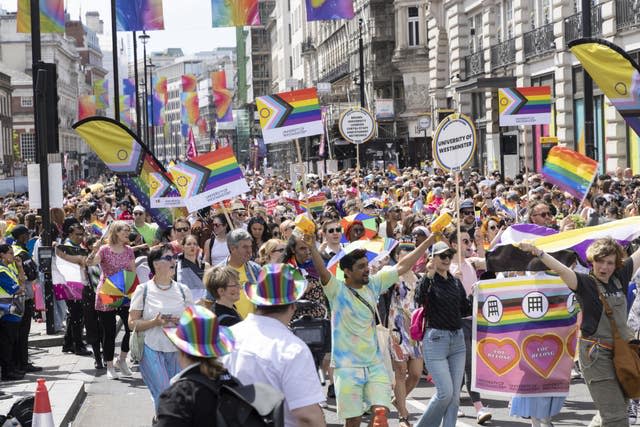Tens of thousands march in Pride parade in central London
Tens of thousands of people marched, many in colourful costumes, in this year’s Pride parade in central London.
The annual event, which had the theme #WeAreEverywhere in 2024, is a demonstration of LGBTQ+ pride and solidarity which celebrates diversity and fosters inclusion.
The parade was kicked off at midday by London’s Labour Mayor Sadiq Khan and his wife, Saadiya Khan, who stood at the front alongside the London Assembly chairman Andrew Boff, a Conservative, who is gay.

The event culminated in a mass gathering at Trafalgar Square where attendees enjoyed musical acts as free, cold soft drinks were handed out to crowds that had spent the day in the warm sun.
Alena Firestone, a 21-year-old student from Washington DC, in the US, said: “I’ve been to pride marches in DC and Philadelphia, and I saw that they were doing one in London so I wanted to see what it was all about.”
Ms Firestone went to watch the parade with her friend, Tamara Whitehead, 22, who studies with her at University College London.
Ms Firestone said: “In Washington, you march within the parade. But here, by standing on the side, you get a better feel for it.”

Among the myriad groups represented on the parade were Tesco workers, a marching band who treated crowds to a popular brass-version of Toxic by Britney Spears, and Ishigaki Ju-Jitsu – the UK’s largest LGBT+ martial arts club.
As the parade went down Piccadilly, spectators and participants danced and sang to loud pop music being pumped out of a Heart radio float.
Queers For Palestine marchers chanted “there is no pride in genocide” as they walked down Piccadilly.
The 50-person group held posters accusing Israel of genocide and condemning “pinkwashing” – the accusation that Israeli takes a progressive position on gay rights to improve its international reputation.

Asked why she wanted to march with the group, one young woman who did not want to be identified replied: “Free Palestine.”
Amran Khan, who did not want to give their age, said they were against pinkwashing.
Asked what they made of criticisms that Queers For Palestine ignore the limited gay rights within Palestinian society, they said: “I can’t speak because I’m not from there, but you have to be in a privileged position to ask that question.”
They said the group was getting a “very positive” reception from the crowd.

Another marcher, Tahir Kesai, said: “We decided to march because we think it’s important to be here. We’re too passionate about this cause not to participate.”
The 50-year-old from Windsor said: “Being gay means different things in different parts of the world.
“I don’t agree you have to be gay in a western way. I think people perceive it differently. I don’t think Israel is that gay friendly, either.”
Onlooker Wes, 42 and a GP from Surrey who did not want to give his surname, said he thought it was a “positive thing” that the group were part of the parade.

Ben, 44, a surgeon, also from Surrey, said: “Pride is a political event. It’s their freedom of speech.”
Christian counter-protesters gathered outside the parade reciting religious sermons criticising the march.
The group of seven men and one woman stood within a fenced off section adjacent to the route of the parade.
Several police officers were stationed around the counter-protest, set-up on Piccadilly, to prevent potential clashes.

A middle-aged man addressed the parade through a loudspeaker and was met with jeers from marchers ridiculing him.
Beside the counter-protest was a cardboard cut-out of Jesus Christ holding a sign saying “I’m sorry about them” with an arrow pointing towards the group.
Jenny Watson, 32, organised an alternative gathering for lesbians separate from the Pride parade.
The group met by the Emmeline Pankhurst statue at 11am on Saturday to chant and discuss themes around “lesbian resistance”.

One of the chants included: “Lesbians, not queer, we march with no fear.”
Ms Watson, a town planner from Belfast, said: “We didn’t want to advertise it because we didn’t want to be ambushed. (Our event) was not a protest, it’s a celebration.”
She said: “I’ve been coming to Pride since I was 18 – then it was easy, simple and fun.
“But it’s been taken over. The last time I went was two years ago. Towards the end of the parade I noticed this bus full of men in kink outfits with ball gags. I thought, what has this become?
“I don’t feel that it represents lesbians any more. It’s not welcoming.
“They said we don’t respect their values, but what are their values? Men can be women, and women can be men?
“Stonewall (the LGBT campaign group set-up in 1989) was about presenting gay people as normal, but now it’s turned into a circus. It’s not about saying gay people are normal. Now, there’s people in the LGBT community who just want to be a bit different.”

 Yahoo News
Yahoo News 
